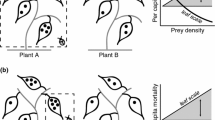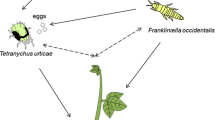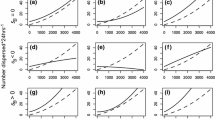Summary
We compared the patch-choice performances of an ambush predator, the crab spider Misumena vatia (Thomisidae) hunting on common milkweed Asclepias syriaca (Asclepiadaceae) umbles, with two stochastic rule-of-thumb simulation models: one that employed a threshold giving-up time and one that assumed a fixed probability of moving. Adult female Misumena were placed on milkweed plants with three umbels, each with markedly different numbers of flower-seeking prey. Using a variety of visitation regimes derived from observed visitation patterns of insect prey, we found that decreases in among-umbel variance in visitation rates or increases in overall mean visitation rates reduced the “clarity of the optimum” (the difference in the yield obtained as foraging behavior changes), both locally and globally. Yield profiles from both models were extremely flat or jagged over a wide range of prey visitation regimes; thus, differences between optimal and “next-best” strategies differed only modestly over large parts of the “foraging landscape”. Although optimal yields from fixed probability simulations were one-third to one-half those obtained from threshold simulations, spiders appear to depart umbels in accordance with the fixed probability rule.
Similar content being viewed by others
References
Barnard, CF, Brown CAG (1985) Risk-sensitive foraging in common shrews. Behav Ecol Sociobiol 16:161–164
Caraco T, Gillespie RG (1986) Risk-sensitivity: foraging mode in an ambush predator. Ecology 67:1180–1185
Charnov EL (1976) Optimal foraging: the marginal value theorem. Theor Popul Biol 9:129–136
Fritz RS, Morse DH (1981) Nectar parasitism of Asclepias syriaca by ants: effect on nectar levels, pollinia insertion, pollinaria removal and pod production. Oecologia 50:316–319
Fritz RS, Morse DH (1985) Reproductive success and foraging of the crab spider Misumena vatia. Oecologia 65:194–200
Gould SJ, Lewontin RC (1979) The spandrels of San Marco and the Panglossian paradigm: A critique of the adaptationist programme. Proc R Soc London, Ser B 205:581–598
Heinrich B (1983) Do bumblebees forage optimally, and does it matter? Am Zool 23:273–281
Janetos AC, Cole BJ (1981) Imperfectly optimal animals. Behav Ecol Sociobiol 9:203–210
Kacelnik A (1984) Central place foraging in starlings (Sturnus vulgaris). I. Patch residence time. J Anim Ecol 53:283–299
Kacelnik A, Houston AI, Krebs JR (1981) Optimal foraging and territorial defence in the great tit (Parus major). Behav Ecol Sociobiol 8:35–40
Krebs JR, Stephens DW, Sutherland WJ (1983) Perspectives on optimal foraging. In: Brush AH, Clark GA Jr (eds) Perspectives in ornithology. Cambridge University Press, New York, pp 165–216
McNamara JM (1982) Optimal patch use in a stochastic environment. Theor Popul Biol 21:269–288
McNamara JM, Houston AI (1980) The application of statistical decision theory to animal behaviour. J Theor Biol 85:673
McNamara JM, Houston AI (1985) A simple model of information use in the exploitation of patchily distributed food. Anim Behav 33:553–560
Morse DH (1979) Prey capture by the crab spider Misumena calycina (Araneae: Thomisidae). Oecologia 39:309–319
Morse DH (1981a) Prey capture by the crab spider Misumena vatia (L.) (Thomisidae) on three common native flowers. Am Midl Nat 105:358–367
Morse DH (1981 b) Modification of bulble bee foraging: the effect of milkweed pollinia. Ecology 62:89–97
Morse DH (1985) Milkweeds and their visitors. Sci Am 253:112–119
Morse DH (1986a) Foraging behavior of crab spiders (Misumena vatia) hunting on inflorescences of different quality. Am Midl Nat 116:341–347
Morse DH (1986b) Inflorescence choice and time allocation by insects foraging on milkweed. Oikos 46:229–236
Morse DH, Fritz RS (1982) Experimental and observational studies of patch choice at different scales by the crab spider Misumena vatia. Ecology 63:172–182
Morse DH, Fritz RS (1987) The consequences of foraging on reproductive success. In: Kamil AC, Krebs JR, Pulliam HR (eds) Foraging behavior. Plenum Press, New York, pp 443–455
Author information
Authors and Affiliations
Rights and permissions
About this article
Cite this article
Kareiva, P., Morse, D.H. & Eccleston, J. Stochastic prey arrivals and crab spider giving-up times: simulations of spider performance using two simple “rules of thumb”. Oecologia 78, 542–549 (1989). https://doi.org/10.1007/BF00378746
Received:
Issue Date:
DOI: https://doi.org/10.1007/BF00378746




